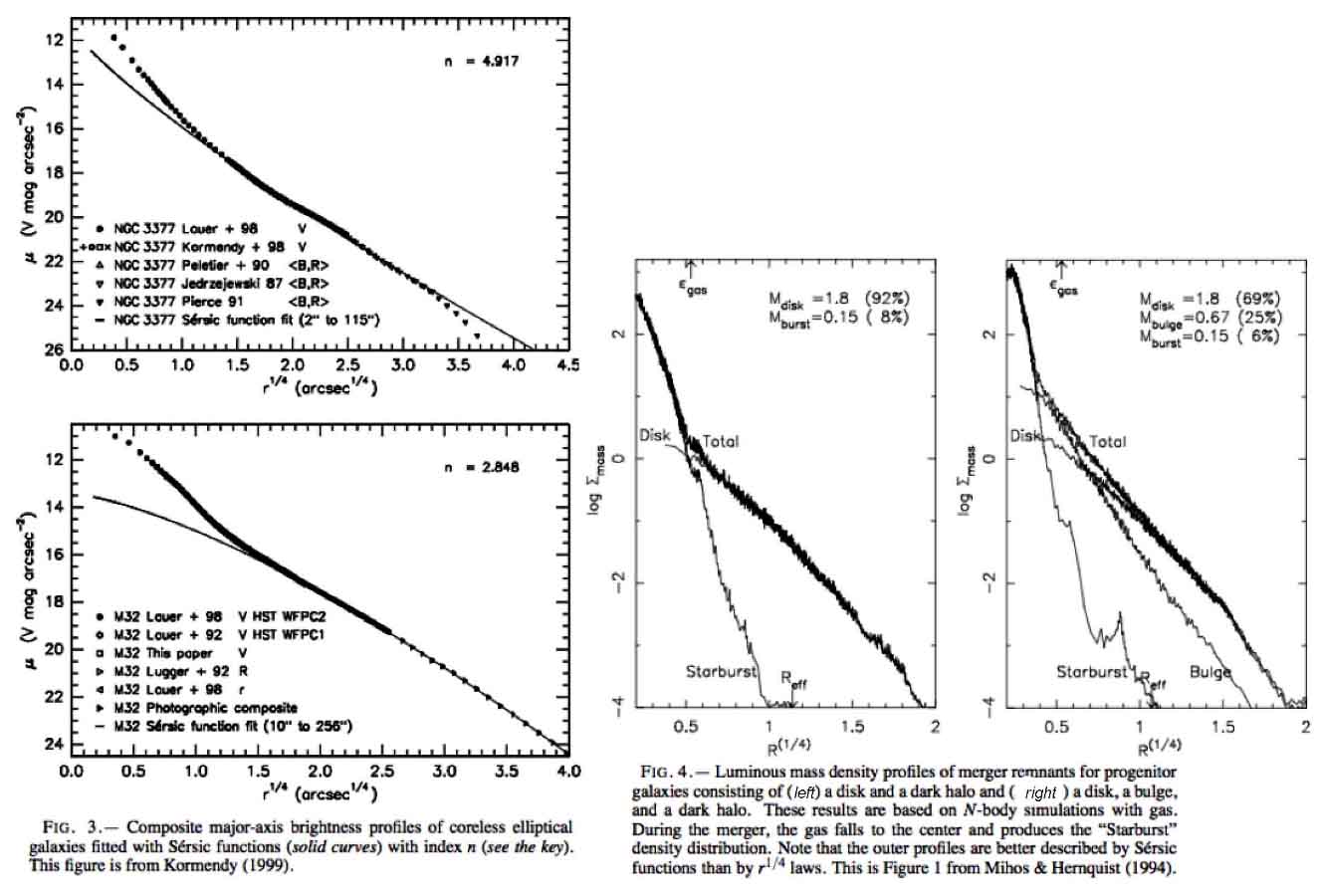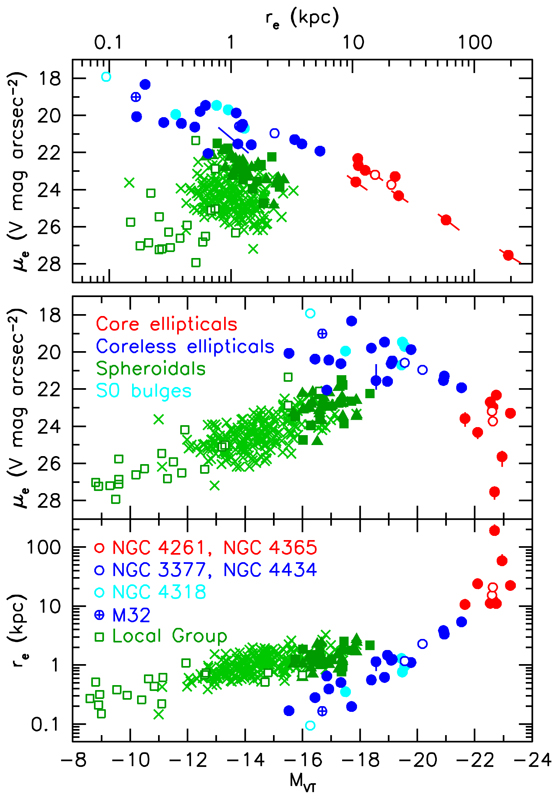Kormendy, Fisher, Cornell, & Bender (2009, ApJS, 182, 216)
Structure and Formation of Elliptical and Spheroidal Galaxies
Abstract With Selected Figures
New surface photometry of all known elliptical galaxies in the Virgo cluster is combined with published data to derive composite profiles of brightness, ellipticity, position angle, isophote shape, and color over large radius ranges. These provide enough leverage to show that Sersic log(surface brightness) proportional to r^(1/n) functions, where r = radius, fit the surface brightness profiles of nearly all ellipticals remarkably well over large dynamic ranges. Therefore we can confidently identify departures from these profiles that are diagnostic of galaxy formation.
Two kinds of departures are seen at small radii. All 10 of our ellipticals with total absolute magnitudes M_VT <= -21.66 have "cuspy cores" -- that is, "missing light" -- at small radii. NGC 4472 is an example. Cores are well known and naturally scoured by binary black holes that form in dissipationless ("dry") galaxy mergers.

Part of Figure 11 in the paper, this shows the composite V-band brightness profile of NGC 4472, the brightest galaxy in the Virgo cluster. It is a typical giant elliptical with a "core". That is, in the central few arcsec of the galaxy, the observed brightness profile departs from the fitted Sersic function (black curve) as the surface brightness profile beomes almost flat. But the rest of the galaxy -- almost all of the stellar mass -- is remakably well fitted by a single Sersic function with index n = 5.99 (key). The top panel shows the deviations of the observed profile from that Sersic function as a function of radius. Except in the core, they are tiny. Note: the Sersic fit is made between the radii identified in both panels by the vertical dashes.
All 17 ellipticals with -21.54 <= M_VT <= -15.53 do not have cores. We find a new distinct component in these galaxies: All coreless ellipticals in our sample have extra light at the center above the inward extrapolation of the outer Sersic profile. For example:

Again part of Figure 11 of the paper, this shows the composite V-band brightness profile of one of the brightest elliptical galaxies that has central extra light above the inward extrapolation of the outer Sersic function fit (black curve). Again, all but a few percent of the light of the galaxy is accurately Sersic (top panel). But the galaxy has central "extra light" -- not central "missing light" -- and that extra light correlates very well with other properties. For example, the Sersic index is 3.17, much smaller than that in NGC 4472. The systematic differences can be understood as being a consequence of different formation histories. We suggest that these galaxies were formed in ("wet") mergers in which cold gas in the progenitor galaxies fell toward the center during the merger and constructed the extra light component in a burst of star formation.

In large ellipticals, the excess light is spatially resolved. As shown in the above figure, it resembles the the central components predicted in numerical simulations of mergers of galaxies that contain gas. In the simulations, gas clouds collide with each other in the gravitational chaos of galaxy mergers; they fall toward the center, undergo a starburst, and build a compact stellar component that, as in our observations, is distinct from the Sersic-function main body of the elliptical. But ellipticals with extra light also contain supermassive black holes. Why did the black hole binaries that should have formed in the galaxy merger not scour a core? We suggest that the starburst has swamped core scouring by binary black holes. That is, we interpret extra light components as a signature of formation in dissipative ("wet") mergers.
Besides extra light, we find three new aspects to the "E--E" dichotomy into two types of elliptical galaxies. Core galaxies are known to be slowly rotating, to have relatively anisotropic velocity distributions, and to have boxy isophotes. We show that they have Sersic indices n > 4 uncorrelated with galaxy luminosity. They also are alpha-element enhanced, implying short star formation timescales. And their stellar populations have a variety of ages but mostly are very old. Extra light ellipticals generally rotate rapidly, are more isotropic than core Es, and have disky isophotes. We show that they have n =3 +- 1 almost uncorrelated with galaxy luminosity and younger and less alpha-element-enhanced stellar populations. These are new clues to galaxy formation. We suggest that extra light ellipticals got their low Sersic indices by forming in relatively few binary mergers, whereas giant ellipticals have n > 4 because they formed in larger numbers of mergers of more galaxies at once plus later heating during hierarchical clustering.
We confirm that core Es contain X-ray-emitting gas whereas extra light Es generally do not. This leads us to suggest why the E--E dichotomy arose. If energy feedback from active galactic nuclei -- essentially: from "mini-quasars" -- requires a working surface of hot gas, then this is present in core galaxies but absent in extra light galaxies. We suggest that this energy feedback is a strong function of galaxy mass. It is weak enough in small ellipticals not to prevent merger starbursts, but strong enough in giant ellipticals and their progenitors to make dry mergers dry and to protect old stellar populations from late star formation that destroys alpha element enhancement. Thus all of the observational aspects of the E--E dichotomy naturally contribute to and are consistent with our suggested two different paths for the formation of elliptical galaxies.
Finally, we verify that there is a strong dichotomy between elliptical and spheroidal galaxies. Their properties are consistent with our understanding of their different formation processes -- mergers for ellipticals and conversion of late-type galaxies into spheroidals by environmental effects and by energy feedback from supernovae.

Figure 37 -- The dichotomy between elliptical and spheroidal galaxies: Ellipticals (blue and red points) and S0 bulges (turquoise points) together define a Fundamental Plane in parameter space that has small scatter when seen nearly edge-on (top panel) and that is clearly distinct from the almost-perpendicular sequence of spheroidal galaxies (green points). It is even more distinct when near-central parameters are used (see the paper). Here r_e is the "effective radius" that contains half of the light of the galaxy and mu_e is the surface brightness at r_e. These are the parameters of Sersic function fits to the major-axis profiles. The total absolute magnitude M_VT is measured by adding up all the light in the profile. The symbols are explained in the paper. The two distinct parameter sequences are consistent with our understanding of their different formation processes: galaxy mergers for ellipticals and conversion of late-type galaxies into spheroidals by environmental effects and by energy feedback from supernovae. KFCB confirms results of Kormendy (1985) and (1987). It is discussed in more detail in this paper, which makes the case that Sph galaxies are nothing more and nothing less than S0 galaxies that contain no bulge component. Thus this paper proposes a natural "home" for Sph galaxies in a revised Hubble galaxy classification scheme.